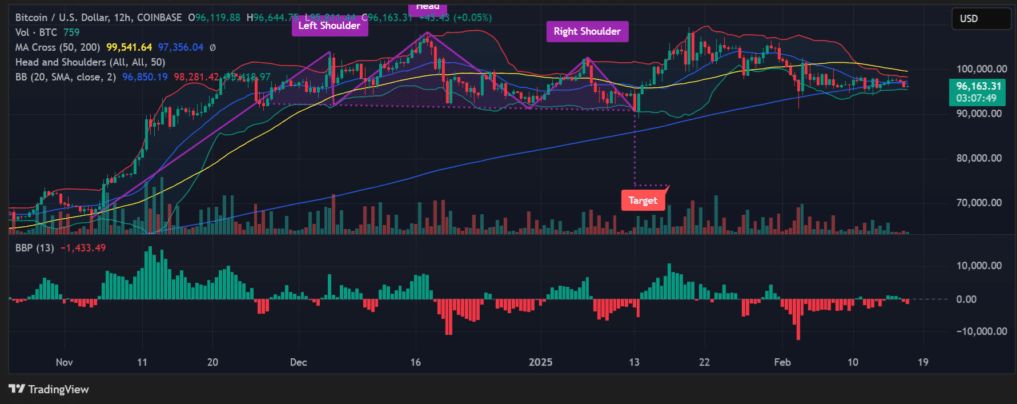With market uncertainty going on, Bitcoin is at the center of investor conversations. At roughly $96,000, the world’s #1 cryptocurrency is getting attention—not just for its technicals but also for Michael Saylor’s insight. Saylor’s recent commentary reinforces his point that buying Bitcoin strengthens the network; selling weakens long-term value. In today’s article we’ll look at Bitcoin’s technicals, moving averages, and breakout or breakdown scenarios to see if BTC can get through this hurdle or if more corrections are coming.
- Saylor’s Enduring Belief and Market Context
- Technical Analysis: Head and Shoulders Pattern
- Historical Buying and Selling Pressure: Lessons from the Past
- Bitcoin’s Next Move: Key Levels and Scenarios
- Risks and Considerations for Short-Term Traders
- Long Term: Saylor’s Bitcoin
- Conclusion
- FAQs
- 1. What does the Head and Shoulders pattern mean for Bitcoin?
- 2. Why are the 50-day and 200-day MAs important?
- 3. How does Saylor’s view impact the market?
- 4. What are the key support and resistance levels?
- 5. How do you balance short-term risk with long-term confidence?
- Glossary
- References
Saylor’s Enduring Belief and Market Context
Michael Saylor is one of the most important voices in the crypto space. His long-term Bitcoin conviction remains unwavering even as recent technicals are flashing caution. Reported in our earlier news reports was his latest mantra which he repeated:
“When you buy Bitcoin, you strengthen the network. When you sell Bitcoin, you weaken it.”
This echoes past episodes where major market events like Tesla’s $1.5 billion Bitcoin purchase in early 2021 triggered huge price moves. Conversely, heavy sell offs like the miners in 2014 drove price below $200. Saylor’s point is that while short-term price swings can be wild, the underlying network effect and scarcity of Bitcoin is the long-term value.
Technical Analysis: Head and Shoulders Pattern
A key part of Bitcoin’s chart right now is the Head and Shoulders pattern—a classic technical that often means a trend reversal. At the moment, Bitcoin is around $95,452. The pattern looks like this:
- The left shoulder was the initial rally.
- The head was the higher peak.
- The right shoulder was the lower high.
If the neckline of this pattern breaks, technical analysts think Bitcoin could drop to $85,000. So traders need to keep an eye on this pattern as a confirmed breakdown would shift momentum to the bears.In addition to the Head and Shoulders pattern, Bitcoin’s position versus its moving averages gives us more clues on its near term direction. Bitcoin is below the 50 day Moving Average (around $99,541) and the 200 day Moving Average (around $97,356). This “death cross” means bearish momentum will prevail unless Bitcoin gets back above these levels.

Bollinger Bands shows BTC is near the lower band (around $96,850) which means high volatility. A recent squeeze in the bands means a breakout is possible but the direction is unknown. The Bull-Bear Power (BBP) is at -1,433.49 which means weakening bullish momentum and more selling pressure in the short term.
Historical Buying and Selling Pressure: Lessons from the Past
Looking at history can provide context for the current market. Past episodes have shown how buying pressure can drive rapid moves upwards and selling pressure can drive steep falls. For example Tesla’s big buy in 2021 was a catalyst for a quick rally, showing that big inflows can change market sentiment fast. Conversely in 2014 big sell offs especially by miners caused a long term down trend and pushed Bitcoin’s price to all time lows.
Saylor’s reminder about the network-strengthening benefits of holding Bitcoin is a call to focus on the long-term fundamentals. While history shows the potential for volatility, it also shows that changes in investor behavior and sentiment often drive big changes in market dynamics. The current mix of technical signals and macro uncertainty means Bitcoin is at a crossroads. A big move – either up above key resistance or down after a breakdown – will redefine its short-term trajectory.
Bitcoin’s Next Move: Key Levels and Scenarios
Bitcoin’s next move seems to be dependent on several key support and resistance levels. Analysts agree that breaking above $100,000 will re-establish the bullish momentum and bring back investor confidence. But failing to hold the levels – especially if BTC goes below $95,000 – will trigger a deeper correction to the $85,000 zone predicted by the Head and Shoulders pattern.
Several things will decide Bitcoin’s next move:
- Support Levels: Holding above $95,000 and, importantly, the neckline of the Head and Shoulders pattern is key.
- Resistance Levels: An upward move above $100,000 will unlock buying interest and signal a reversal of the current downtrend.
- Technical Indicators: The death cross and the proximity to the lower Bollinger Band is a warning to be aware of.
Traders are faced with a dual challenge – balancing Saylor’s long term optimism with the short term technicals that suggest caution. In this environment even small changes in market sentiment can have big impacts on Bitcoin’s price.
Risks and Considerations for Short-Term Traders
While Saylor strongly supports Bitcoin’s long-term narrative, the short-term outlook is risky. The technicals suggest BTC could see more selling if the bearish pattern plays out. A break below the Head and Shoulders neckline would likely prompt a quick move to the lower targets, possibly to $85,000.
Broader market factors—regulatory uncertainty and macro headwinds—can increase volatility. Short-term traders should be extra cautious during mixed technical signals. In these situations, profit taking, sudden reversal, or external shocks (e.g., bad news about global financial policies) can trigger big moves.
Traders must be on high alert, using strict risk management and watching key levels and indicators. For those with a longer-term time frame, Saylor’s hold is a good argument, but timing the market in the short term is hard.

Long Term: Saylor’s Bitcoin
Despite the technical challenges and near term uncertainty, Saylor’s long term confidence in Bitcoin is not going away. He says every buy of Bitcoin reinforces the network and is a hedge against inflation. This long term view has been a key part of his public commentary and is still influential for institutions and retail alike.
From a strategic perspective the current phase – consolidation and mixed signals – may be a pause before Bitcoin continues its up move. If BTC can get past short term hurdles and reclaim its moving averages it could be the start of a long rally that validates Saylor’s call.
For those with a long term view, focusing on the bigger picture and the fundamentals of Bitcoin may be more important than reacting to short term price action. While the next few days or weeks may be tough, the fundamental case for Bitcoin is still strong.
Conclusion
Bitcoin’s current price and formation of a head-and-shoulders reversal pattern encapsulate the battle between technicals and long-term fundamentals. Saylor’s “buy and hold” call is the optimistic counterpoint to the short-term bearish signals. But the road ahead is full of key support and resistance levels that will decide BTC’s next move.
A break above $100,000 could start the up move, and a break below support could start a move down to $85,000. As traders weigh these options, a balance between short-term technicals and long-term conviction will be key. For now, Bitcoin is a battlefield of competing forces, and the next move will have big implications for the overall market.
Stay updated with Deythere as we’re available around the clock, providing you with updated information about the state of the crypto world.
FAQs
1. What does the Head and Shoulders pattern mean for Bitcoin?
A classic reversal pattern, a confirmed break of the neckline could see Bitcoin drop to $85,000.
2. Why are the 50-day and 200-day MAs important?
Bitcoin below these levels and the resulting death cross is bearish and will continue unless BTC gets back above.
3. How does Saylor’s view impact the market?
Saylor’s consistent “buy Bitcoin strengthens the network” message is a long term bullish narrative even in short term technical woes.
4. What are the key support and resistance levels?
Resistance is at $100,000, support is critical above $95,000. Break below these levels and it could lead to a deeper correction.
5. How do you balance short-term risk with long-term confidence?
Short-term traders need to manage risk through analysis and risk management, long-term investors can focus on Bitcoin fundamentals and Saylor’s eternal bullishness.
Glossary
Head and Shoulders: A chart pattern that means a trend reversal.
Moving Averages (MA): A calculation to analyze price trend by averaging past prices, usually 50-day and 200-day.
Death Cross: A bearish signal when a short-term MA crosses below a long-term MA.
Bollinger Bands: A volatility indicator that uses standard deviations to create upper and lower bands around a moving average.
Bull-Bear Power (BBP): An indicator that measures buying versus selling pressure.
Legal Disclaimer
This article is for informational purposes only and not financial advice. Please do your own research and consult a financial advisor before making any investment decisions.



















































































































